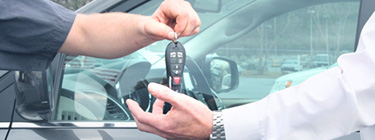Why Should I Choose a Side Entry Wheelchair Van Conversion?
If You Plan To Drive, It's the Way To Go
Even if you won't be driving, a side entry conversion is an excellent choice for your personal minivan. You may have already noticed that more used accessible vans for sale feature side-entry ramp deployment than rear deployment, and there are several good reasons for the popularity of the side entry style.
Ramped-Up Power
Remote power is standard on side entry conversions. One button on your key fob operates your van's side door, and one "up" or "down" button retracts or deploys its wheelchair ramp. Easy! Even more, the AMS Vans wheelchair van ramp deployment system can be stopped mid-cycle if ever needed. Most ramp systems do not have this potential accident-saving feature. In addition, because power ramps have manual back-up systems, you'll never be stuck inside or outside your van. Along with a remote control, you'll have a powered ramp-deployment button conveniently located in the cabin's interior, too.
A Driving Passion
Those whose mobility impairment doesn't affect their ability to drive wheelchair vans will find the side entry the better option for entering the vehicle and, then, either transferring from the wheelchair to an adaptive driver's seat or having a removable driver's seat and a wheelchair lock-down system in the driver's position.
Can't Beat the Seating
Many agree that the side-entry conversion offers wheelchair users the best seat in the house (the best seat in the van)--the front-passenger seat. Have a wheelchair docking system installed beneath the removable seat, and when the seat's out, you're in! Combine wheelchair tie-downs or a docking system in mid-cabin with a removable front-passenger seat and docking system in that position and you've got room for two wheelchair passengers, as well as the additional ambulatory-passenger seating in the cabin's factory standard third row.
What's the Flip Side?
Because side ramp deployment--the clear favorite in handicap vans--is more complex to manufacture than the rear entry, and because powered ramps are standard in this version (as opposed to manually operated ramps, which are standard in rear entry conversions), you'll pay more to have your minivan converted for side-door entry. For many wheelchair users, however, that's not a "convenience fee" but rather a value for all the benefits a side entry provides.
Finally, parking is a consideration. A parked handicapped van, regardless of your entry/exit point, requires 8 feet of clearance where the ramp is deployed to accommodate the ramp's length and provide room for a wheelchair or scooter to maneuver away from the ramp and move in a specific direction.
The rear-entry van can park in non-handicap, delineated spaces in parking lots or curbside city parking, because the ramp extends behind the vehicle. With the side entry, you'll need to seek out handicap van parking spaces to deploy the side entry ramp and exit. But, when all is said and done...
...the positives of a side entry wheelchair accessible van conversion will help you work it all out with a smile on your face!


